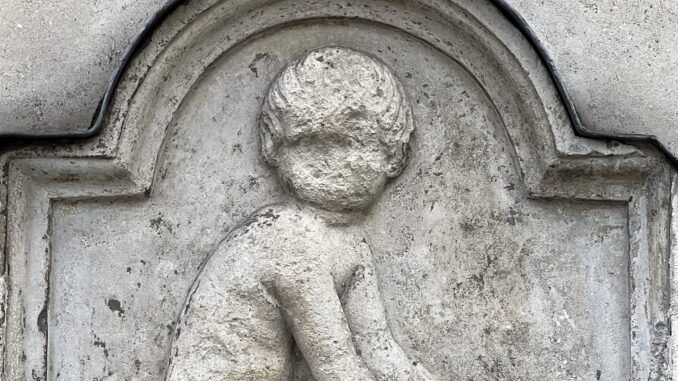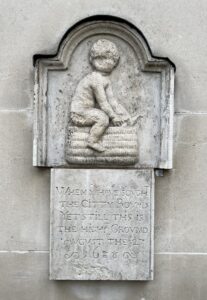
When yu have sought the Citty Round, Yet still this is the highest Ground.
August the 27 1688
Step out of the tube at St Paul’s station and look at the wall of the adjacent Caffe Nero and you will find yourself staring at a 340 year old mystery.
This is the frieze/bas relief of the so-called ‘Panyer Boy’ (see pic below), a small boy sitting astride what most assume is a bread basket (known as a pannier/panier/panyar – other spellings are available), which is above another carved stone that bears the text above. These mark one end of what used to be called Panyer (or Panyar/Pannier etc) Alley.
The alley features on pre-Great Fire maps and ran from Paternoster Row to what is now Newgate Street (but was then called Blow Bladder Street, from one of the trades associated with the butchering of animals – the area north of the street was a medieval ‘shambles’). At the southern end of the alley was the Panyer inn, but whether the inn was named for the alley or vice versa, I’ve been unable to discover.
John Stow in his 1603 Survey of London mentions the alley and says that the then nearby church of St Michael ad Bladum (sometimes called St Michael le Querne) stood on what “was sometime a corn market, stretching by west to the shambles”. The assumption is that the cornmarket meant that bakers (and their panyers) were thus long associated with the area.
Stow mentions “a sign” that marks Panyer Alley, but doesn’t describe it. Many have speculated (we’re in the soft marshes of speculation, hypothesis, assumption etc rather than the hard ground of fact here) that Stow’s sign is The Boy, which seems a bit of a leap. Others say that The Boy was the inn’s marker (like a pub sign today) that survived the Great Fire which destroyed the inn. Again, something of a leap, and it means that the plaque with the text would therefore be a later addition.
In Strype’s 1720 survey of the City both The Boy and text are referenced, so we can be comfortable with the two plaques being at least 300 years old, but in some ways the mystery (and the conjecture) deepens, because Stype suggests that The Boy is holding “a Bunch of Grapes, as it seems to be, held between his naked Foot and Hand: in token, perhaps, of Plenty”.
The Boy today is so weathered and worn that it is impossible to see that he is holding anything, but earlier observers have mentioned grapes, or perhaps a loaf of bread being taken out of – or put into – the basket.
There’s one more element to the mystery. The text talks about “the highest ground”, i.e. the highest point of the City, but various people have deduced that this is wrong, and that the acme was actually Cornhill which was (possibly, probably) a foot higher. I’m not sure 12” difference in height could have been divined that easily in 1688, so it might simply be that whoever put up the plaque believed this to be the highest point, but we’re unlikely ever to know.
And perhaps that’s our only conclusion about the whole thing; it’s simply another of those nests of mysteries of which London is full, that allow our imaginations a little exercise.
Some links:
- IanVisits has some information on how the plaques have been moved around over the past 150 years or so: https://www.ianvisits.co.uk/articles/londons-alleys-panyer-alley-ec2-31609/
- The Grub Street Project (a collection of references to and maps of the Alley) https://www.grubstreetproject.net/places/3411
- London Signs and Inscriptions (1893) https://www.gutenberg.org/files/53105/53105-h/53105-h.htm#i4
- Text of John Strype’s Survey https://www.dhi.ac.uk/strype/tableOfcontent.jsp
- Text of John Stow’s 1603 Survey of London https://www.gutenberg.org/files/42959/42959-h/42959-h.htm


